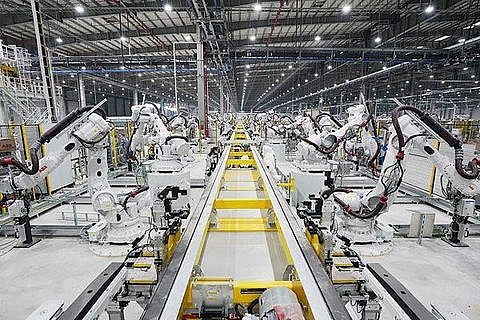Automobile industry develops but local part supply still low
 |
| An automobile manufacturing line of Vinfast in the northern city of Hai Phong. - Photo VNA/VNS |
The report shows that the volume of domestically-assembled cars was 250,000-260,000 units in 2017 and 2018, of which several types have been exported to foreign countries including, Laos, Cambodia, Myanmar and Central America. The industry has contributed billions of US dollars to the State budget, contributing to reducing the trade deficit and creating jobs for more than 120,000 workers.
However, the localisation rate for cars with nine seats and fewer has reached about 7-10 per cent, concentrating on tyres, seats, mirrors, glass, electrics, batteries and plastic products. Meanwhile, the Government’s target was set at 40 per cent in 2005 and 60 per cent in 2010.
MoIT said that up to 80-90 per cent of the main raw materials for components production such as alloy steel, aluminium alloy, plastic beads and hi-tech rubber are currently imported. Every year, businesses have to import about US$2-3.5 billion worth of parts and spare parts for production, assembly and repair of vehicles. Meanwhile, the localisation rate of regional countries has averaged 65-70 per cent. Thailand alone hits 80 per cent.
“If domestic automakers do not soon put in place effective solutions to improve localisation rates, it will be difficult to compete in the regional market,” said the report.
“The domestic market is small, with consumption of more than 300,000 vehicles [including imported ones] per year, while the number of manufacturing and assembling enterprises is high with 56 units so it has not been attractive for businesses to invest in the support industry.”
In the report, the ministry also emphasised the need to promote the development of the automobile and support industry, in which enterprises can make use of its solutions and policies offered by the automobile industry projects of domestic automakers such as Truong Hai Automobile Company (Thaco), Thanh Cong Group, VinFast and others.
The ministry said it was planning to submit to the National Assembly amendments to the application of special consumption tax on cars with a high localisation rate (no tax on locally-manufactured parts).
The ministry has built a pilot part supply chain for automobile manufacturers and assemblers at home and abroad, and studied mechanisms and policies to attract investment from multinational corporations investing in large-scale projects in Vietnam, especially those focused on the brands and models not existing in ASEAN, in order to create conditions for local enterprises to participate deeply in multinational automobile production chains.
According to a ministry report, there are more than 300 enterprises of the country’s total 1,800 parts and spare parts manufacturing enterprises participating in the production network of multinational corporations, of which automobile manufacturing and assembly industry reached 7-10 per cent, the remainder being the textile and footwear industry with 40-45 per cent, electronics and telecommunications with 15 per cent and specialized electronics and high-tech industries with 5 per cent.
Chief Representative of Japan External Trade Organisation (JETRO) Hironobu Kitagawa said at a signing ceremony of co-operation between Reed Tradex Vietnam and Jetro held in Ha Noi recently that in 2018, the number of investment projects from Japan into Vietnam reached the highest level of 630 projects with total investment of about US$8 billion.
He said nearly 70 per cent of Japanese enterprises had invested in Vietnam, responding that "They want to expand their business, however, one of the difficulties is the low localisation rate of materials and parts.”
"The localisation rate of Japanese enterprise in Vietnam is 36.3 per cent, lower than China's rate of 66 per cent and Thailand's rate of 57 per cent. Therefore, our enterprises are forced to import from other countries like Thailand and China," Kitagawa said.
"This is the main cause of increased costs and great risks for Japanese enterprises operating in the manufacturing sector in Vietnam, and also the cause of difficulties in maintaining middle and long-term investments in the country," he added.
The JETRO representative also said that restrictions on mechanisms and policies to support the development of small and medium enterprises were one of the existing problems in Vietnam.
What the stars mean:
★ Poor ★ ★ Promising ★★★ Good ★★★★ Very good ★★★★★ Exceptional
Related Contents
Latest News
More News
- Sustainability a core value for DKSH’s vision (January 07, 2026 | 16:00)
- People encouraged to contribute and grow at AstraZeneca Vietnam (January 07, 2026 | 15:48)
- Dat Bike accelerates sustainable mobility (January 07, 2026 | 15:24)
- Innovation to support modern healthcare development (January 07, 2026 | 10:00)
- Six localities record double-digit growth as regional performance diverges in 2025 (January 06, 2026 | 18:00)
- E-commerce market undergoes transformation amid rising competition and regulation (January 06, 2026 | 17:54)
- Vietnam’s industrial output hits seven-year high in 2025 (January 06, 2026 | 17:47)
- GELEX’s credit rating outlook upgraded to 'Positive' by VIS Rating (January 06, 2026 | 16:49)
- Finance sector lays firm groundwork for 2026 after major reform (January 06, 2026 | 15:30)
- Vietnam’s seafood exports surpass $11 billion in 2025 (January 06, 2026 | 08:51)

 Tag:
Tag:


















 Mobile Version
Mobile Version